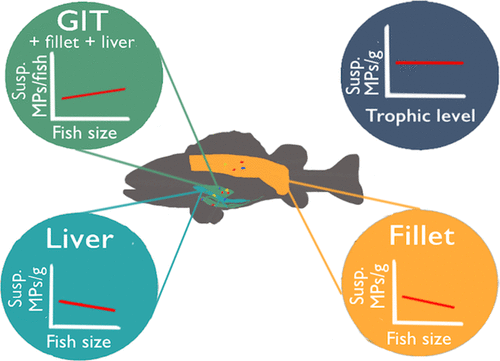当前位置:
X-MOL 学术
›
Environ. Sci. Technol.
›
论文详情
Our official English website, www.x-mol.net, welcomes your
feedback! (Note: you will need to create a separate account there.)
Evidence of Microplastic Translocation in Wild-Caught Fish and Implications for Microplastic Accumulation Dynamics in Food Webs
Environmental Science & Technology ( IF 10.8 ) Pub Date : 2021-09-09 , DOI: 10.1021/acs.est.1c02922 Hayley K McIlwraith 1 , Joel Kim 1 , Paul Helm 2, 3 , Satyendra P Bhavsar 2, 3 , Jeremy S Metzger 2 , Chelsea M Rochman 1
Environmental Science & Technology ( IF 10.8 ) Pub Date : 2021-09-09 , DOI: 10.1021/acs.est.1c02922 Hayley K McIlwraith 1 , Joel Kim 1 , Paul Helm 2, 3 , Satyendra P Bhavsar 2, 3 , Jeremy S Metzger 2 , Chelsea M Rochman 1
Affiliation

|
The presence of microplastics within the gut of animals is well documented. Whether microplastics bioaccumulate in organisms and biomagnify in food webs remains unclear and relies on the ability of microplastics to translocate to other tissues. Here, we demonstrate the widespread presence of microplastics and other anthropogenic microparticles in the gastrointestinal tract, fillet, and livers of seven species of sportfish from Lake Simcoe, Ontario, Canada. Larger fish had a higher microplastic load compared to smaller fish, but the opposite trend was observed with translocated microplastics standardized by fish mass (i.e., smaller fish contained more translocated particles per gram wet weight than larger fish). Moreover, we observed no evidence of biomagnification as there was no significant relationship between the trophic level and total or translocated microplastics per individual. Overall, this suggests that microplastics are translocating, but that excretion of translocated particles or growth dilution may be occurring rather than bioaccumulation and biomagnification. Moreover, the assemblages of shapes and material types varied among tissues, suggesting that particle characteristics may predict biological fate. Our findings highlight the need for further work to understand the mechanisms of microplastic translocation and excretion and the implications for the dynamics of microplastics accumulation in food webs and human exposure.
中文翻译:

野生捕捞鱼类中微塑料易位的证据以及对食物网中微塑料积累动力学的影响
动物肠道内存在微塑料是有据可查的。微塑料是否会在生物体内积累并在食物网中进行生物放大仍不清楚,这取决于微塑料转移到其他组织的能力。在这里,我们证明了来自加拿大安大略省 Simcoe 湖的七种游鱼的胃肠道、鱼片和肝脏中广泛存在微塑料和其他人为微粒。与较小的鱼相比,较大的鱼具有更高的微塑料负载,但观察到以鱼质量标准化的易位微塑料的相反趋势(即,较小的鱼每克湿重含有更多的易位颗粒比较大的鱼)。而且,我们没有观察到生物放大的证据,因为营养水平与每个个体的微塑料总量或易位微塑料之间没有显着关系。总的来说,这表明微塑料正在转移,但转移颗粒的排泄或生长稀释可能正在发生,而不是生物积累和生物放大。此外,不同组织的形状和材料类型的组合各不相同,这表明粒子特征可以预测生物命运。我们的研究结果强调需要进一步研究以了解微塑料易位和排泄的机制以及微塑料在食物网和人类暴露中积累动态的影响。但可能发生的是易位颗粒的排泄或生长稀释,而不是生物积累和生物放大。此外,不同组织的形状和材料类型的组合各不相同,这表明粒子特征可以预测生物命运。我们的研究结果强调需要进一步研究以了解微塑料易位和排泄的机制以及微塑料在食物网和人类暴露中积累动态的影响。但可能发生的是易位颗粒的排泄或生长稀释,而不是生物积累和生物放大。此外,不同组织的形状和材料类型的组合各不相同,这表明粒子特征可以预测生物命运。我们的研究结果强调需要进一步研究以了解微塑料易位和排泄的机制以及微塑料在食物网和人类暴露中积累动态的影响。
更新日期:2021-09-21
中文翻译:

野生捕捞鱼类中微塑料易位的证据以及对食物网中微塑料积累动力学的影响
动物肠道内存在微塑料是有据可查的。微塑料是否会在生物体内积累并在食物网中进行生物放大仍不清楚,这取决于微塑料转移到其他组织的能力。在这里,我们证明了来自加拿大安大略省 Simcoe 湖的七种游鱼的胃肠道、鱼片和肝脏中广泛存在微塑料和其他人为微粒。与较小的鱼相比,较大的鱼具有更高的微塑料负载,但观察到以鱼质量标准化的易位微塑料的相反趋势(即,较小的鱼每克湿重含有更多的易位颗粒比较大的鱼)。而且,我们没有观察到生物放大的证据,因为营养水平与每个个体的微塑料总量或易位微塑料之间没有显着关系。总的来说,这表明微塑料正在转移,但转移颗粒的排泄或生长稀释可能正在发生,而不是生物积累和生物放大。此外,不同组织的形状和材料类型的组合各不相同,这表明粒子特征可以预测生物命运。我们的研究结果强调需要进一步研究以了解微塑料易位和排泄的机制以及微塑料在食物网和人类暴露中积累动态的影响。但可能发生的是易位颗粒的排泄或生长稀释,而不是生物积累和生物放大。此外,不同组织的形状和材料类型的组合各不相同,这表明粒子特征可以预测生物命运。我们的研究结果强调需要进一步研究以了解微塑料易位和排泄的机制以及微塑料在食物网和人类暴露中积累动态的影响。但可能发生的是易位颗粒的排泄或生长稀释,而不是生物积累和生物放大。此外,不同组织的形状和材料类型的组合各不相同,这表明粒子特征可以预测生物命运。我们的研究结果强调需要进一步研究以了解微塑料易位和排泄的机制以及微塑料在食物网和人类暴露中积累动态的影响。











































 京公网安备 11010802027423号
京公网安备 11010802027423号